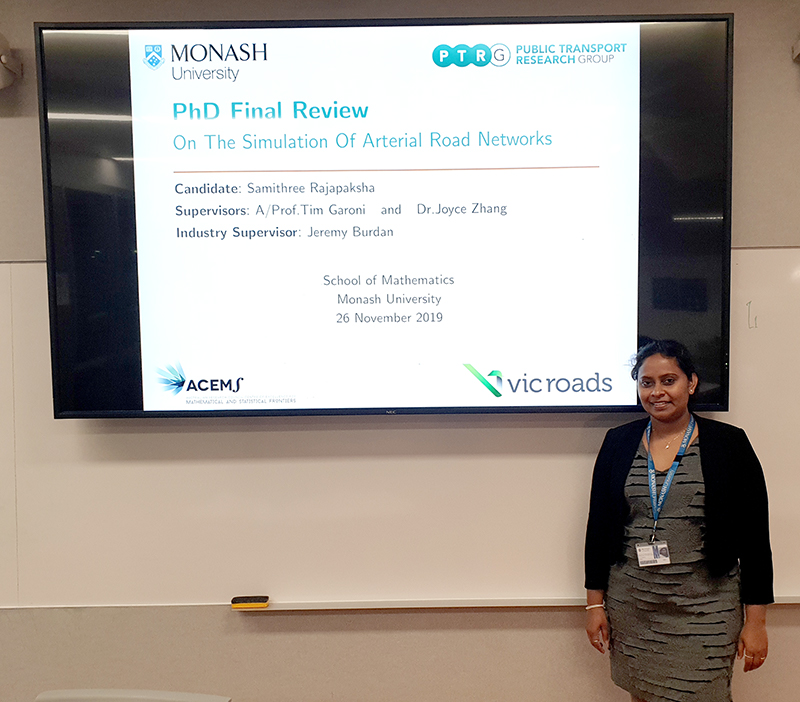
VicRoads
VicRoads plans, develops and manages the arterial road network and delivers road safety initiatives and customer focused registration and licensing services.
The key role of VicRoads is to help provide Victorians with safe and easy connections to the people and places that matter most to them.
VicRoads is now part of the Department of Transport, providing an integrated state transport department.
ACEMS collaborates with VicRoads to address cutting edge traffic modelling technologies as well as operations research and other methodological approaches.

Overview
From its start, 2020 was a year of significant change for VicRoads. The COVID-19 pandemic impacted the use of public transport, and traffic, both in Victoria and more generally. Further, VicRoads and Public Transport Victoria had recently come together with the Department of Transport to create a properly integrated transport department. The VicRoads and ACEMS partnership celebrated the completion of a co-supervised PhD student, and new ideas for collaboration, and opportunities, were seeded for 2021 along with new data assets to support this.
Industry PhD Student: Samithree Rajapaksha
VicRoads supported ACEMS Monash/UoM PhD student Samithree Rajapaksha in her studies on the Simulation of Arterial Road Networks.
This valuable industry support included provision of a PhD stipend and in-kind contributions including PhD industry supervision from VicRoads’ Jeremy Burden, consultation, and the provision of access to data and models for consideration. Her academic supervisors were ACEMS Monash CI Tim Garoni and ACEMS UoM’s AI Joyce Zhang.
2020 was Samithree’s final year of her PhD. Jeremy Burden was on her PhD panel. Notwithstanding the challenges of the pandemic and lockdowns, Samithree passed her thesis, studying the headways and bunching effects of trams which is of interest to VicRoads for improved transport.
“One of the primary objectives of my research was to study the calibration of traffic models via Approximate Bayesian Computation (ABC). Furthermore, we identified that understanding the statistical distribution of link travel times is also important for meso- and macro-scale modelling of vehicular dynamics in arterial road networks. After having many discussions with Jeremy (VicRoads), we realised that accurately modelling the dwell time at bus or tram stops is an important challenge in simulations of on-road public transport. Via a combination of simulation and direct statistical survey, we studied the distribution of the dwell time at selected tram stops in inner Melbourne.” - Samithree Rajapaksha

About Samithree’s PhD Research
Traffic simulation models have become an increasingly important tool for investigating vehicular dynamics in arterial networks. In her thesis Samithree studied three distinct, but related, topics in the field of traffic simulation. Specifically, calibration of traffic models via Approximate Bayesian Computation (ABC); the form of link travel time distributions, particularly in the presence of traffic lights; and the form of dwell time distributions for on-road public transport, in particular, for trams.
Read more in Samithree’s published PhD Thesis

Samithree Rajapaksha at her PhD pre-submission review in November 2019, attended by VicRoads
Value of Industry and ACEMS Academic Supervision and Networks
Reflecting on her PhD experience, Samithree is happy that her PhD research and the new data she collected can contribute useful knowledge for industry, as part of their continued efforts towards improving transport. She said having the support of VicRoads also helped her professionally, including by expanding her network and knowledge of industry. In addition to the support of her ACEMS supervisors, she also enjoyed the benefit of ACEMS extended network, including the opportunity to work with ACEMS CI Scott Sission (UNSW).
National-Scale Human Mobility Data Asset
ACEMS supported efforts with researchers including CSIRO’s Dr Jess Liebig, as a new ACEMS AI, to improve human mobility data for research. This included outreach to relevant stakeholders, such as VicRoads and others, providing an overview of proposal to develop a national data asset relevant to stakeholders in research and industry. This led to CSIRO applying for ARDC funding to create a comprehensive national scale human mobility data asset for Australia, transformed into a consistent format suitable for analysis across a broad range of research areas, including (most saliently for the pandemic of 2020) modelling the spread of infectious diseases through and across populations.
It is intended that CSIRO will lead this project, and the final data asset will be hosted and made publicly available on the Australian Urban Research Infrastructure Network (AURIN). There may be further opportunities in 2021 related to this with the Department of Transport, as a relevant stakeholder.
Opportunities for 2021
In 2021, a briefing for VicRoads will be planned for Samithree to present her research to a wider audience. VicRoads - as part of the broader Department of Transport – also aims to look at research opportunities with ACEMS. ACEMS researchers active with VicRoads and otherwise in relation to transport, traffic, and data useful for research in these areas, have expressed an interest to share knowledge, conduct a briefing, and discuss new ideas and opportunities for engagement and collaboration. Topic areas ripe for future opportunities include public transport skip stop scheduling, analysis of the relationship between land use and traffic congestion, traffic perimeter control for limiting congestion, knowledge-sharing regarding queuing theory, as well as harnessing existing and new datasets, models and simulations of, available to, and developed by both partners and their extended networks.